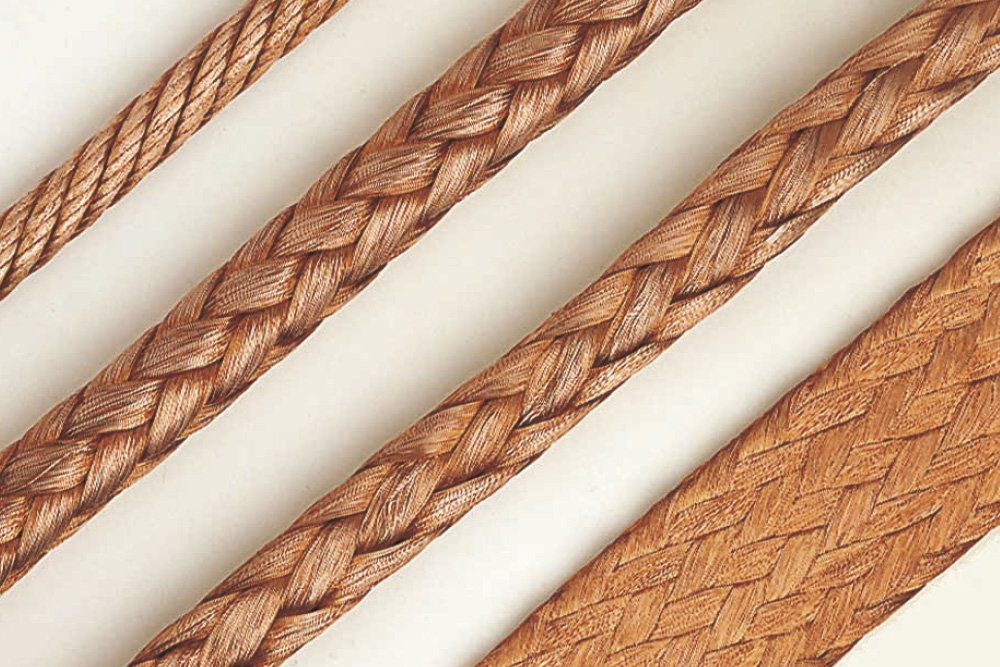Real cross-sectional area: can be obtained by adding all the cross-sectional areas of each wire that make up the strip or braid.
Apparent cross-sectional area: is equal to the resultant area of the external dimensions of the braid, and it is equal to about twice of the real cross-sectional area.
Flexibility: depends essentially on the mechanical resistance of the material used and on its diameter.Usually, electrical applications require annealed electrolytic copper, red or tinned.
Highly flexible “ES”: single strand wire with a diameter of 0.05 to 0.07
Very very flexible “S”: single strand wire with a diameter of 0.10
Very flexible “ST”: single strand wire with a diameter of 0.15
Flexible “EF”: single strand wire with a diameter of 0.20
Semi flexible “F”: single strand wire with a diameter of 0.25 to 0.30
| CHARACTERISTICS OF BRAIDS | |||
| Type | Definition | Advantages | Disadvantages |
| TWISTED CABLE |
The strands are wound like a propeller. Its flexibility is determined by its winding pitch. |
External appearance is a perfect cylinder. Available in very long pieces without shunts. Low production costs. Flexible in every respect. |
Does not accept torsion, work hardening, if the torsion is in the propeller’s direction, widening and risk of breakage if torsion is in the opposite direction. Strands may become wider when curved, separation of strands when the strip is cut. |
| ROUND BRAID |
The strands are wound like propellers but in opposite direction. The winding pitch determines flexibility. |
Extreme flexibility, more flexible than braids of equal crosssectional area and than single stranded wires: when this type of braid is cut the strands do not separate. Flexible in all directions. Resists torsion to the point that the strands do not widen. Square or rectangular sections with round edges can be obtained, with a good flat flexibility. |
Not a perfect cylinder. Great lengths cannot be obtained, higher costs with respect to the braid type. |
| FLAT BRAID |
The strands are wound like propellers but in opposite direction. Its cross-section is rectangular and not extremely thick. |
Great flat flexibility. Thickness is within limits with respect to its width. Strong sections can be made by overlapping many strips. |
Limited sections. Low lateral flexibility. Limited connection tightness due to overlapping of strips which oppose each other when flexing occurs. |
| FLAT TUBULAR TYPE BRAID |
The strands are wound like propellers but in opposite direction and tubular shape.They are laminated in order to take on a rectangular shape.This is the most commonly used braid. |
Great flat flexibility. They can be made very thick with respect to its width. Strong sections can be made by using only one braid or big sections can be made by using many successive braids. |
Poor lateral flexibility. |
The current flow values are provided for information and are true for braids and twisted
cables, which are used horizontally. The real values may stray within tolerance, from
the values reported in the table, because it depends on the braid’s or cable’s
composition, i.e. number and diameter of the single strands of wire, external diameter
of the cable or external dimensions of the braid.
| MAXIMUM ALLOWABLE CURRENT FLOW FOR ANNEALED BRAIDS AND TWISTED CABLES | ||||||||||||||||||||||||||
| Sezione nominale mm. | 1 | 1,5 | 2,5 | 4 | 6 | 10 | 16 | 25 | 35 | 50 | 70 | 100 | 150 | 200 | 250 | 300 | 400 | 500 | 600 | 800 | 1000 | 1200 | 1500 | 2000 | 2500 | 3000 |
| Corrente massima ammissibile A | 18 | 21 | 30 | 40 | 55 | 85 | 120 | 150 | 195 | 250 | 300 | 370 | 480 | 610 | 700 | 780 | 950 | 1100 | 1250 | 1500 | 1800 | 2000 | 2200 | 2400 | 2750 | 3000 |
The values which are shown in the table below are to be considered at a room temperature
of 35°C (95°F) and the maximum operating temperature shall be 70°C (158°F).
The manufacturer is not responsible, under any circumstance for the values reported
in the table above.


